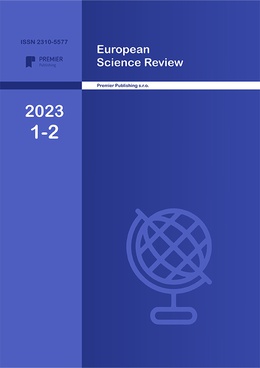The Study of Proteolytic activity of Phytopathogenic Rhodococcus, Pseudomonas and Xanthomonas Some Strains
Authors
Marina Melkumyan

Share
Annotation
Abstract The problem of phytopathogenic microorganism harm for is very important for agriculture and horticulture. Proteases various types are well-known for human and animal opportunistic pathogens. Current research is devoted to the study of proteolytic activity and antibiotic resistance in 9 strains very common phytopathogens: Rhodococcus fascians, Pseudomonas syringae, pv. syringae, P. syringae, pv. tabaci, Xanthomonas beticola, X. vesicatoria. Abstrakt (Anmerkung) Das Problem der Schädigung durch phytopathogene Mikroorganismen ist für die Landwirtschaft und den Gartenbau sehr wichtig. Proteasen verschiedener Arten sind für humane und tierische opportunistische Pathogene gut bekannt. Die aktuelle Forschung widmet sich der Untersuchung der proteolytischen Aktivität und Antibiotikaresistenz in 9 Stämmen sehr verbreiteter Phytopathogene. Rhodococcus fascians, Pseudomonas syringae, pv. syringae, P. syringae, pv. tabaci, Xanthomonas beticola, X. vesicatoria.
Keywords
Authors
Marina Melkumyan

Share
References:
- Scala V., Pucci N., Loreti S. The diagnosis of plant pathogenic bacteria: a state of art, Front Biosci (Elite Ed). 2018. - Vol.10.- No.3. - p. 449-460.
- Zhang M., Chen X.-R., Wang X., Li G., Ma L., Gou J.-Y., Wu J., Wang X. Editorial: Molecular interactions between crops and phytopathogens volume III: Vegetables and other crops, Front Plant Sci. 2022. – Vol. 13. – p. 5.
- McDonald B.A., Stukenbrock E.H. Rapid emergence of pathogens in agro-ecosystems: global threats to agricultural sustainability and food security, Philos Trans R Soc Lond B Biol Sci. 2016. – Vol. 371 – No. 1709. – p.2.
- Martins P.M.M., Merfa M.V., Takita M.A., De Souza A.A. Persistence in Phytopathogenic Bacteria: Do We Know Enough? Front Microbiol. 2018. – Vol. 9 - p. 6.
- Song B., Seiber N.J., Duke S.O., Qing X. LiGreen Plant Protection Innovation: Challenges and Perspectives, Engineering (Beijing). 2020 May; 6(5): 483–484.
- Gigante V., Sati H., Beyer P. Recent advances and challenges in antibacterial drug development, ADMET DMPK. 2022; 10(2): 147–151.
- Manyi-Loh C., Mamphweli S., Meyer E., Okoh A. Antibiotic Use in Agriculture and Its Consequential Resistance in Environmental Sources: Potential Public Health Implications, Molecules. 2018. – Vol. 23 – No.4. – p.795.
- Kumar S.B., Arnipalli S.R., Ziouzenkova O. Antibiotics in Food Chain: The Consequences for Antibiotic Resistance, Antibiotics (Basel). 2020. – Vol. 9. – No. 10. – p. 688.
- Mikaelyan A.R., Babayan B.G., A.A. Vartanyan A.A., Tokmajyan H.V. Tartaric acid synthetic derivatives effect on phytopathogenic bacteria, Agronomy Research, 2022. – Vol. 20. – N.3. – p. 644–659.
- Sandri A., Lleo M.M., Signoretto C., Boaretti M., Boschi F. Protease inhibitors elicit anti-inflammatory effects in CF mice with Pseudomonas aeruginosa acute lung infection, Clin Exp Immunol., 2021ю – Vol. 203. – No. 1. – p. 87 – 95.
- Babayan B. G., Hovhannisyan N. A., Hovhannisyan A. M., Sargsyan A. S., Davidyan T. S. Resistance to β-Lactam Antibiotics in Some Soil Stenotrophomonas and Pseudomonas, J. The Scientific Heritage Budapest, 2019. – Vol 2. – No. 34 (34). – p. 32–38.
- Mills J.T. Use of photographic film as a substrate for localization of protease activity by fungi on rape seeds, Canadian J. of Plant Pathology, 2009. – Vol. 5. – p. 21-24.
- Mahdhi A., Hmila Z., Behi A., Bakhrouf A. Preliminary characterization of the probiotic properties of Candida famata and Geobacillus thermoleovorans, Iran J Microbiol. 2011. –Vol. 3. – No. 3. – p. 129–134.
- Jean B. P., et al. Performance Standards for Antimicrobial Susceptibility Testing, 2017. Suplem., 27th ed. – M.– p. 100.
- Lucotte G., Baneyx F. Introduction to Molecular Cloning Techniques. Wiley-Blackwell, ISBN978–0471188490, 1993 – p. 32.
- Jutras P.V., Grosse‐Holz F., Kaschani F., Kaiser F., Michaud D., van der Hoorn R.A.L. Activity‐based proteomics reveals nine target proteases for the recombinant protein‐stabilizing inhibitor Sl CYS8 in Nicotiana benthamiana, Plant Biotechnol J. 2019. – Vol.17 – No.8. – p. 1670–1678.
- Tang A., Caballero A.R., Marquart M.E., Bierdeman M.A., O'Callaghan R.J. Mechanism of P. aeruginosa Small Protease (PASP), a Corneal Virulence Factor, Invest Ophthalmol Vis Sci. 2018. – Vol. 59. – No.15 – p. 5993–6002.
- Khoshbakht R., Kabiri M., Neshani A., Khaksari M.N., Sadrzadeh S.M., Mousavi S.M., Ghazvini K., Ghavidel M. Assessment of antibiotic resistance changes during the Covid-19 pandemic in northeast of Iran during 2020–2022: an epidemiological study, Antimicrob Resist Infect Control. 2022. – Vol.11. – p. 121.
- Babayan B., Mikaelyan A., Asatryan N., Melkumyan M., Bagdasaryan S., Grigoryan A.Tartaric Acid New Synthetic Derivatives Antibacterial Activity against the Phytopathogenic P. syringae, Proceedings of ICARSET, 2021. – p. 1–7.
- Alvarez-Narvaez S. Giguère S., Cohen N., Slovis N., Vázquez-Boland J.A. Spread of Multidrug-Resistant Rhodococcus equi, United States // Emerg Infect Dis. USA, 2021. –Vol. 27 – No. 2. – p. 529–537.


